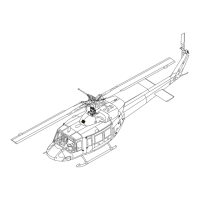BHT-212-MM-1
5-00-00
Page 192 Rev. 14 26 JUN 2013
Export Classification C, ECCN EAR99
— Inspect
1. If a hard landing is suspected, step a through step h shall
be accomplished:
a. Inspect main and tail rotor blades for evidence of strike
damage. If such evidence is found on either rotor, perform
sudden stoppage — power on or off.
b. Visually inspect underside of fuselage and tailboom for
evidence of ground contact.
Chapter 32 c. Perform landing gear deflection check.
(1) If crosstubes have yielded, remove landing gear
and inspect support and attaching structure for signs of yielding
or other damage.
(2) If supports and attaching structure are not
damaged, replace damaged landing gear components.
d. Inspect mast for evidence of hard rotor hub contact
sufficient enough to yield or deform mast.
e. Inspect mast area around pylon mount for loose rivets
or other damage.
f. Inspect tailboom and fuselage attachment for loose
rivets, cracks, or other damage.
g. If no damage other than yielded landing gear
crosstubes has been found at this point, it is reasonably certain
a true hard landing did not occur. For helicopters on the Part A
inspection program, complete a 100 hour /12 month inspection.
For helicopters on the Part B inspection program, complete a 25
hour/15 day inspection and return helicopter to flight status
provided no further evidence of damage is found.
h. If damage is more extensive than landing gear
crosstube yielding, a hard landing has occurred. Comply with
requirements of step 2 through step 4.
5-50. AFTER HARD LANDING (CONT)
DATA REFERENCE INSPECTION TASK DESCRIPTION
INITIAL
MECH OTHER

